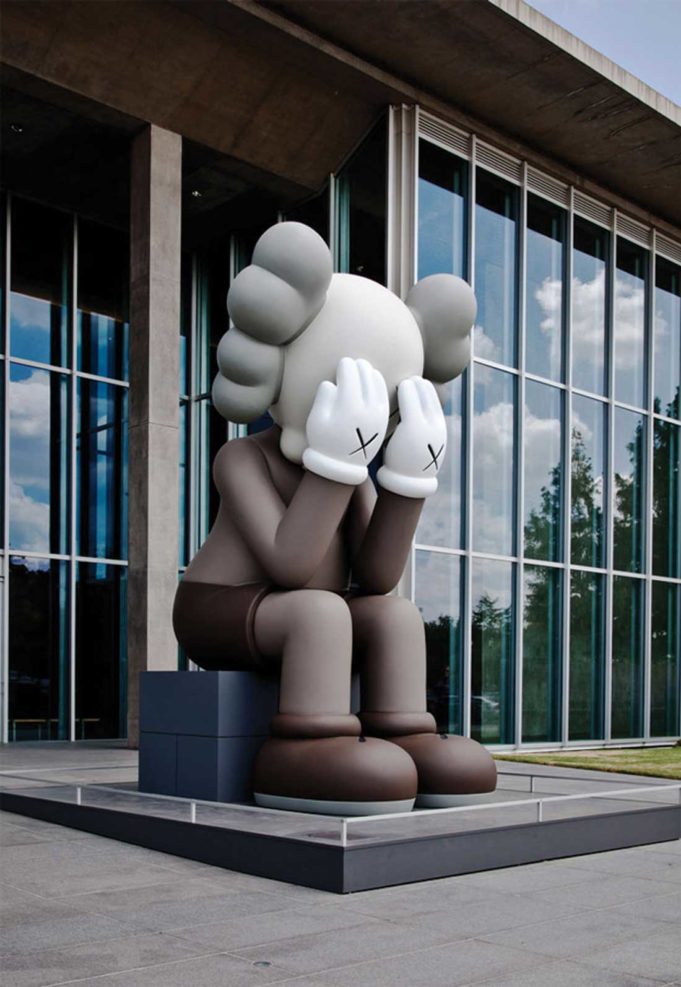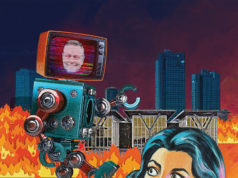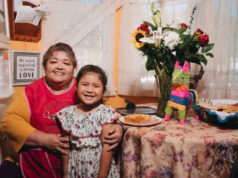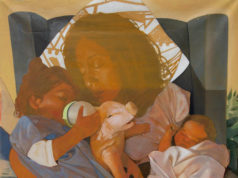Within hours of its opening last Thursday, the website for the gift shop at the Modern Art Museum of Fort Worth crashed due to overwhelming demand for items related to a new exhibition. “Due to extraordinary demand,” the notice read, “inventory is not available for new orders.”
The crash probably owes to the fact that the artist has more than half a million Instagram followers and an international profile. And if the long line on opening day last week was any indication, the Modern’s gonna need a bigger boat (or server).
Featuring more than 100 pieces, ranging from a painted bronze depiction of the artist’s head (“Permanent Thirty-Three”) to a mammoth wood sculpture (“Together”), KAWS: Where the End Starts is the title of both the exhibit and of KAWS’ lone painting in the museum’s collection. Following the artist’s FOCUS exhibition here in 2011 and the subsequent acquisition of “Where the End Starts,” this show serves as the jumping off point for the survey of KAWS’ work over the past 20 years. Twice in as many years, the Modern has brought back for larger exhibitions two artists whose works were part of its FOCUS series, the other being Kehinde Wiley. The formula seems to be: acquire a work of art from a small show and then work with the artist over a few years to present a blockbuster.
The enormous appeal of Brooklyn-based artist Brian Donnelly, a.k.a. KAWS, can be seen as a consequence of an artist who straddles the worlds of both art and design, particularly in the post-Warhol/Keith Herring generation.
[box_info]KAWS: Where the End Starts
Thru Jan 2017 at the Modern Art Museum of Fort Worth, 3200 Darnell St, FW. Free-$10. 817-738-9215.[/box_info]
When graffiti artists enter the white cube world of museums and galleries, the mechanics of production and consumption sometimes kick into high gear –– what was once a dodgy, anonymous gesture becomes rarified and monetized, sparking outcries about selling out and losing street cred. After all, this is the same guy who picked the locks of ad boxes at bus stops in Manhattan in the 1990s to create his own versions of those ads before re-inserting them into those same boxes.
KAWS seems acutely aware of this dichotomy, and he exploits its mechanism to both popular and critical success. He had already visited Japan to work on making series of toy works before any major museum shows. Distorting pop iconography to monumental effect has become his trademark, in defiance of or maybe in collusion with the corporations that own these images. The design and fashion company Diesel sent him numerous posters to do with as he pleased, whether or not they ended up in his art practice. Creating characters like Companion (inspired by Mickey Mouse) and Chum (the artist’s take on the Michelin Man) to navigate the space between high/low art and commerce is KAWS’ way of talking about both.
In a recent interview at the Modern, KAWS said, “Companion is a figure in the world now, and it’s not all great out there. He deals with life the way everyone does. Even though I use a comic language, my figures are not always reflecting the idealistic cartoon view that I grew up on, where everything has a happy ending.”
This is as clear a lens to adopt while viewing Untitled (Kimpsons). This series of five acrylic-on-canvas paintings of KAWS/Simpsons combinations in blister packaging is located in the middle gallery of the exhibition. The creation of the series bookends 9/11 (2000–2002) and cannot be viewed entirely outside of that context. If there were ever a need to create a happy place, or to try to deal with a sad one, 2001 in New York would have been it. These works are the only ones in which the design/toy aspect of KAWS’ creations and his fine art side are combined in one fell swoop. Untitled (Kimpsons) features a decapitated Homer in one package with his head in his hands and paintings of Marge, Lisa, and Bart with signature Companion ears and X’s for eyes. Each package contains a painting in an oversized rectangular box with a pre-printed Homer and Marge in the upper corners as Krusty the Clown beckons with open arms. There are also square openings on the back of the packaging that reveal the artist’s signature, as if to emphasize that these are indeed artworks and not toys.
The pieces that make up Where the End Starts aren’t in chronological order, which helps establish relationships between and among the works much like the artist does in his studio. The untitled series from the bus stop ads in the ’90s are near the north end of the galleries, while the recent Five Suspects series is in the middle.
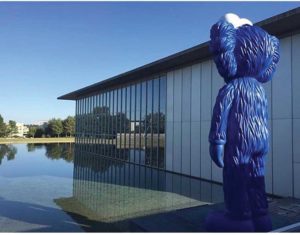
Photo courtesy of the Modern Art Museeum of Fort Worth
KAWS is perhaps best known for his massive sculptures, four of which are included here. But his “BFF” from 2016 is unique among them. The painted navy blue fiberglass-and-metal creature looms 22 feet above the northwest corner of the museum lawn, like a dead-eyed cookie monster, overlooking the pond. It’s easy to miss him because unless you’re in the stairway at the far north section of the museum, or on the north lawn, he’s not in plain view.
I like the humor in this piece. It’s deadpan, and the character is kind of a loner. It also represents a departure from the previous sculptures, with their smooth textures and polished wood surfaces.
Where the End Starts will probably cause another system failure at the Modern and break some kind of attendance record, because the work is popular and Instagram-able and there are versions of it that you can afford. Every museum needs a blockbuster show like this to be able to bring us uncompromisingly challenging works, which most of us tend to ignore but which arguably matter more.
Christopher Blay is an art critic for the Fort Worth Weekly and is curator of Art Corridor II, at Tarrant County College Southeast. He is also an installation artist with a January 2017 exhibition at UNT on the Square in Denton.



